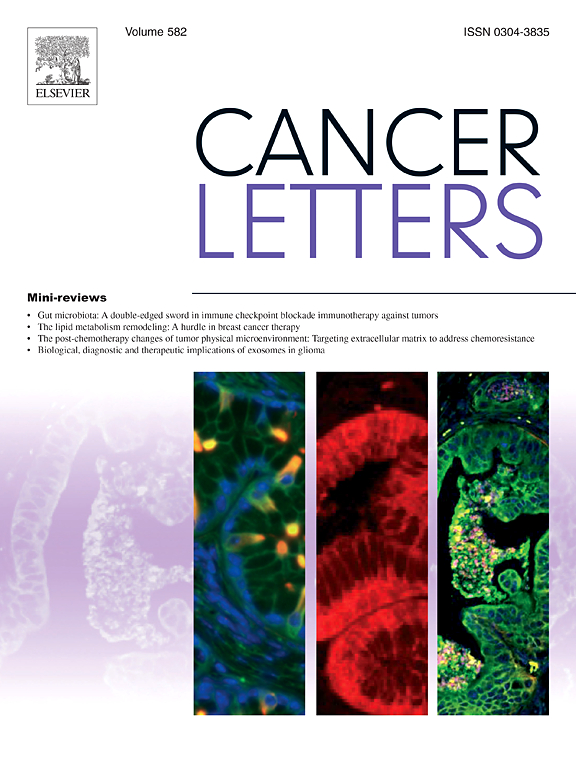CircFLNB upregulated by chemotherapy via alternative splicing suppresses the progression of colorectal cancer
IF 9.1
1区 医学
Q1 ONCOLOGY
引用次数: 0
Abstract
Alternative splicing (AS) is a tightly regulated process that gives rise to proteins with distinct or even opposing functions. But cancer-specific alternative splicing of circRNA formation is less likely to be identified. We identified circFLNB by a circRNA microarray and validated it by quantitative reverse transcription PCR. The role of circFLNB in CRC progression was assessed both in vitro and in vivo, and its downstream target genes were identified and validated in CRC cells by bioinformatics analysis and confirmed by luciferase reporter assays. The dysregulated alternative splicing events and splicing factors in chemotherapy-induced CRC tissues were identified using RNA-seq and rMATS analysis. The clinical implications of circFLNB were assessed in CRC tissue using the nomogram algorithm. We found that circFLNB was weakly expressed in colorectal cancer tissues and cells and its expression was increased by chemotherapy. Functionally, circFLNB repressed the proliferation and invasion of CRC cells in vitro, as well as inhibited the growth of CRC xenografts in mice in vivo. Mechanistically, circFLNB inhibited the proliferation of CRC in vivo and in vitro by targeting the miR-3127-3p/MOB1B/Hippo pathway. Furthermore, our investigation indicated that splicing factors QKI and CELF4 are essential and sufficient for the circFLNB biogenesis through chemotherapy-regulated alternative splicing. A patient prognosis model based on circFLNB expression levels can effectively predict the prognosis of CRC patients. Our research demonstrated that QKI- and CELF4- dependent alternative splicing induced by chemotherapy promotes circFLNB biogenesis, which inhibits CRC tumorigenesis via binding with miR-3127-3p to regulate the MOB1B/Hippo pathway.
化疗通过选择性剪接上调cirflnb抑制结直肠癌的进展。
选择性剪接(AS)是一个受到严格调控的过程,产生具有不同甚至相反功能的蛋白质。但是癌症特异性的环状rna形成的选择性剪接不太可能被识别出来。我们通过circRNA微阵列鉴定了cirflnb,并通过定量反转录PCR验证了它。在体外和体内均评估了circFLNB在CRC进展中的作用,并通过生物信息学分析在CRC细胞中鉴定和验证了其下游靶基因,并通过荧光素酶报告基因检测证实了其作用。使用RNA-seq和rMATS分析鉴定了化疗诱导的结直肠癌组织中失调的选择性剪接事件和剪接因子。使用nomogram算法评估circFLNB在CRC组织中的临床意义。我们发现circFLNB在结直肠癌组织和细胞中表达较弱,且其表达随化疗而升高。在功能上,circFLNB在体外抑制CRC细胞的增殖和侵袭,在体内抑制小鼠CRC异种移植物的生长。在机制上,circFLNB通过靶向miR-3127-3p/MOB1B/Hippo通路,在体内和体外抑制CRC的增殖。此外,我们的研究表明,剪接因子QKI和CELF4是通过化疗调节的选择性剪接实现cirflnb生物发生的必要和充分条件。基于circFLNB表达水平的患者预后模型可以有效预测结直肠癌患者的预后。我们的研究表明,化疗诱导的QKI-和CELF4-依赖的选择性剪接促进了circFLNB的生物发生,其通过与miR-3127-3p结合来调节MOB1B/Hippo通路,从而抑制CRC的肿瘤发生。
本文章由计算机程序翻译,如有差异,请以英文原文为准。
求助全文
约1分钟内获得全文
求助全文
来源期刊

Cancer letters
医学-肿瘤学
CiteScore
17.70
自引率
2.10%
发文量
427
审稿时长
15 days
期刊介绍:
Cancer Letters is a reputable international journal that serves as a platform for significant and original contributions in cancer research. The journal welcomes both full-length articles and Mini Reviews in the wide-ranging field of basic and translational oncology. Furthermore, it frequently presents Special Issues that shed light on current and topical areas in cancer research.
Cancer Letters is highly interested in various fundamental aspects that can cater to a diverse readership. These areas include the molecular genetics and cell biology of cancer, radiation biology, molecular pathology, hormones and cancer, viral oncology, metastasis, and chemoprevention. The journal actively focuses on experimental therapeutics, particularly the advancement of targeted therapies for personalized cancer medicine, such as metronomic chemotherapy.
By publishing groundbreaking research and promoting advancements in cancer treatments, Cancer Letters aims to actively contribute to the fight against cancer and the improvement of patient outcomes.
 求助内容:
求助内容: 应助结果提醒方式:
应助结果提醒方式:


